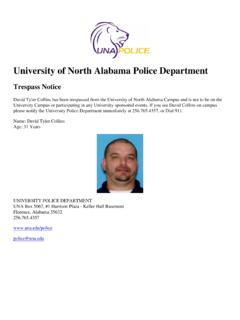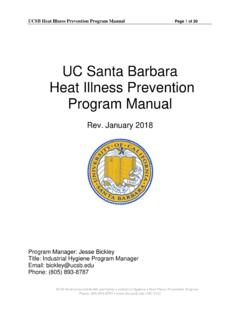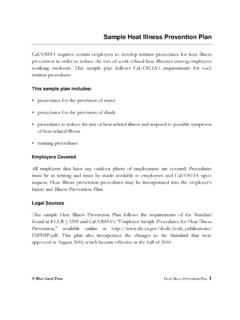Transcription of Training PREVENTION OF HEAT AND COLD CASUALTIES
1 Department of the Army *TRADOC Regulation 350-29 Headquarters, United States Army Training and Doctrine Command Fort Monroe, Virginia 23651-1047 20 January 2010 Training PREVENTION OF heat AND cold CASUALTIES _____ FOR THE COMMANDER: OFFICIAL: DAVID P. VALCOURT Lieutenant General, Army Deputy Commanding General/ Chief of Staff History. This publication is a rapid action revision. The portions affected by this rapid action revision are listed in the summary of change. Summary. This regulation prescribes policy and provides guidance to commanders in preventing environmental ( heat or cold ) CASUALTIES . Applicability. This regulation applies to all Active Army and Reserve component Training conducted at service schools, Army Training centers, or other Training activities under Headquarters, Army Training and Doctrine Command (TRADOC) control.
2 Proponent and exception authority. The proponent for this regulation is the Deputy Commanding General/Chief of Staff, TRADOC. The proponent has the authority to approve exceptions or waivers to this regulation that are consistent with controlling law and regulations. Army management control process. This regulation does not contain management control provisions. Supplementation. Supplementation of this regulation and establishment of command and local forms are prohibited without prior approval from the Deputy Chief of Staff, G-6 (ATIM), 84 Patch Road, Bldg 162, Fort Monroe, VA 23651-1047. _____ *This regulation supersedes TRADOC Regulation 350-29, 16 July 2003. TRADOC Reg 350-29 2 Suggested improvements. Users are invited to send comments and suggested improvements on DA Form 2028 (Recommended Changes to Publications and Blank Forms) through channels to Command Surgeon s Office, TRADOC, ATTN: ATBO-M, 60 Ingalls Road, Fort Monroe, VA 23651-1032.
3 Suggested improvements may also be submitted using DA Form 1045 (Army Ideas for Excellence Program (AIEP) Proposal). Availability. This publication is distributed solely through the TRADOC Homepage at Summary of Change TRADOC Regulation 350-29 PREVENTION of heat and cold CASUALTIES This rapid action revision, dated 20 January 2010 - o Defines responsibilities of subordinate agencies and unit commanders (para 1-3). o Prescribes standards to identify Soldiers who are at risk for heat or cold injury, including preexisting conditions and taking medications ( paras 2-1d and 3-1d). o Prescribes annual heat and cold injury PREVENTION Training ( paras 1-3d(1) and (2)). o Places emphasis on assessment of a casualty s mental status, rather than body temperature, in determining heat injury ( para D-2d).
4 O Removes intravenous (IV) therapy as an initial treatment by nonmedical responders (para 2-2d(2)(d)). o Describes procedure for use of iced sheets (paras 2-2d(2)(c) and D-2). o Provides definitions for heat injuries and cold injuries that require reporting, in agreement with operations and safety reporting (para 1 -3c(5)). o Replaces text and graphics on PREVENTION and treatment measures with links to current resources (para 1-3e(1)). o Uses the term "casualty" to mean any person who is lost to the organization as the result of an injury and "injury" to refer to the condition resulting from extremes of temperature or prolonged exposure (throughout document). TRADOC Reg 350-29 3 Contents Chapter 1 Introduction .. 4 1- 1. Purpose .. 4 1- 2. References .. 4 1- 3. Responsibilities.
5 4 Chapter 2 PREVENTION and Treatment of heat Injuries .. 6 2- 1. Basics of heat injury risk .. 6 2- 2. heat injury PREVENTION and treatment .. 8 2- 3. Other conditions associated with hot weather, overexertion, and overhydration .. 9 Chapter 3 PREVENTION and Treatment of cold Injuries .. 10 3- 1. Basics of cold injury risk .. 10 3- 2. cold injury PREVENTION and treatment .. 11 3- 3. Other conditions associated with cold weather .. 12 Appendix A References .. 12 Appendix B Composite Risk Assessment Worksheet heat Injury .. 14 Appendix C Composite Risk Assessment Worksheet cold Injury .. 15 Appendix D Instructions on Use of Iced Sheets .. 15 Appendix E Instructions on Use of the WBGT .. 18 Appendix F Methods for Controlling Risk of heat and cold Injury .. 19 Glossary .. 21 Figure List Figure B-1 Sample composite risk assessment worksheet heat injury.
6 14 Figure C-1 Sample composite risk assessment worksheet cold injury .. 15 Figure F-1 Colored beads on 550 cord .. 19 Figure F-2 Knotted 550 20 Figure F-3 Beads on 550 cord .. 20 _____ TRADOC Reg 350-29 4 Chapter 1 Introduction 1- 1. Purpose This regulation prescribes policy and provides guidance to commanders in preventing environmental ( heat or cold ) CASUALTIES . 1- 2. References Appendix A contains required and related publications and referenced forms. 1-3. Responsibilities Commanders and supervisors at all levels are responsible for protecting Soldiers and civilian personnel from the adverse effects of heat and cold , and for ensuring subordinate leaders are trained in recognition and treatment of heat and cold injury. a. Deputy Chief of Staff, G-3/5/7. Receive and forward compliance reports from centers and schools for annual heat and cold injury PREVENTION and treatment Training (see paras 1-3d(1) and (2)).
7 B. TRADOC Surgeon. Prepare and disseminate memorandums on behalf of CG, TRADOC prompting compliance among TRADOC subordinate commands with hot and cold weather injury PREVENTION Training each year IAW TRADOC Regulation 350-6, para H -12a. c. TRADOC Senior Commanders and TRADOC School and Center Commandants. (1) Ensure appropriate hot weather and cold weather protective items (clothing, shelter) are available to Soldiers. (2) Ensure potable water, ice, and supplemental snacks and beverages are available to Soldiers. Plan for 3 gallons of water per day per Soldier just for drinking. Consider providing flavored electrolyte supplements for water to increase palatability. (3) Ensure medical support and evacuation plans are tested at least annually (see TRADOC Regulation 350-6, para 3 -31c). (4) Establish coordination between the medical treatment facility and Training organizations for assistance from environmental health to: (a) Present annual Training (see paras 2-2 and 3- 2).
8 (b) Assist in development of local composite risk management worksheets (see appendixes B and C). (5) Report heat and cold injuries IAW TRADOC Regulation 1-8, para 2-2b(5). TRADOC Reg 350-29 5 (6) Report compliance with heat injury PREVENTION and treatment Training prior to 15 April each year, and cold injury PREVENTION and treatment Training prior to 15 October each year, thru the TRADOC Emergency Operations Center (EOC) w atch team ( @ ) to the TRADOC Surgeon. d. Brigade Commanders. (1) Conduct heat injury PREVENTION and treatment Training for all subordinate leaders prior to 15 April each year. (2) Conduct cold injury PREVENTION and treatment Training for all subordinate leaders prior to 15 October each year. (3) Adjust Training schedules (for example, train during the cooler part of the day) and locations (for example, indoors or in the shade) as needed to protect Soldiers against extremes of heat and cold .
9 (4) Refer to TRADOC Regulation 385-2, para 1-5b, when making the decision to accept risk. e. Unit Leaders. (1) Download and publish copies of Commander's, Senior NCO's and Instructor's Guide to Risk Management of heat CASUALTIES (available from the Army Center for Health Promotion and Preventive Medicine (CHPPM) Web site at mil/ heat /) and Unit Leader s and Instructor s Risk Management Steps for Preventing cold CASUALTIES (available at ) for local use. (2) Utilize field sanitation team members to monitor conditions of cold and heat and advise on risk factors (see TRADOC Regulation 350-6, para 3 -37). (3) Ensure Soldiers' clothing and equipment is present and serviceable prior to the Training day; recommend modifications of the uniform to senior leadership, based on local conditions.
10 (4) Identify and mark Soldiers who are at risk for heat and cold injury (see references listed at paras 2-2b(1), 3- 2 b(1), and F-1b(2)). (5) Monitor conditions of heat and cold on the Training site (see TRADOC Regulation 350-6, para H-12b(2)). Recommend modifications for scheduling, location, and uniform to senior leadership. (6) Plan for alternate activities and locations for conditions of extreme heat and cold (for example, physical activity or warming shelters in case of extreme cold ). TRADOC Reg 350-29 6 (7) Be prepared to apply iced sheets in case of heat injury. See appendix D for procedures on use of iced sheets. (8) Ensure Soldiers drink sufficient amounts of fluids and consume all their meals. Encourage Soldiers to drink frequently in small amounts and observe their fluid intake.



















